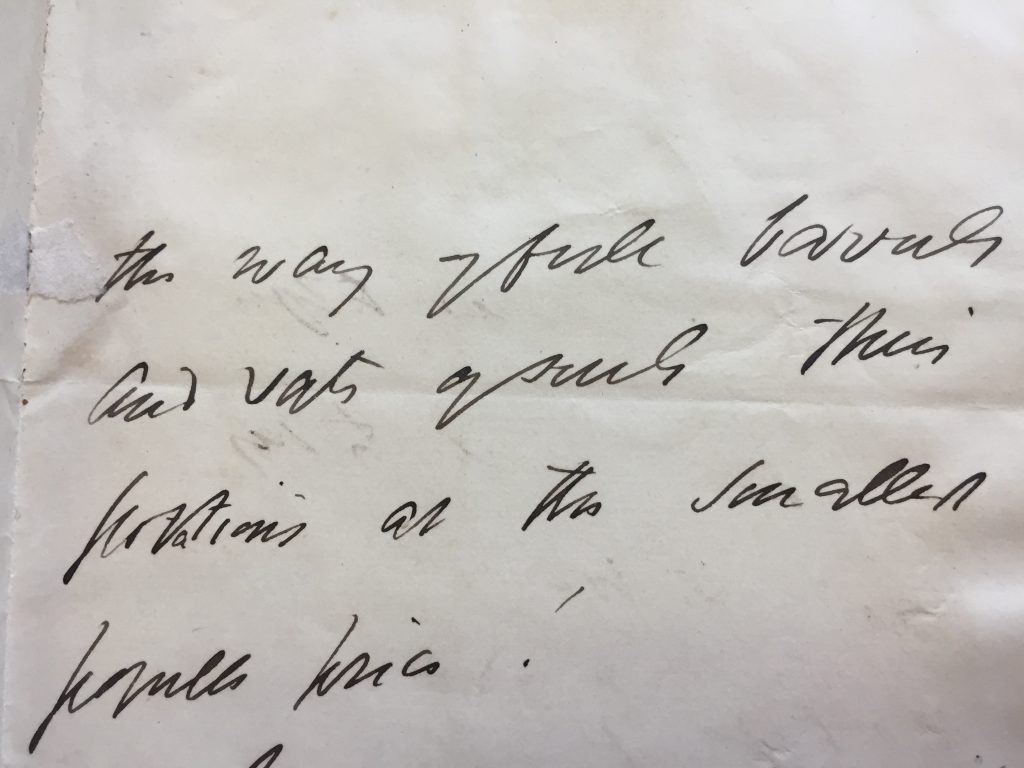By Katie Mackenzie, Museum Studies Summer Intern
Hello! My name is Katie Mackenzie and I am an intern at the Armstrong Browning Library this summer. One of the projects that I am working on is transcribing and preparing Victorian letters to be digitized. Digitizing these Victorian letters will help them to be more accessible to the world as they will be able to be viewed online.
The first Victorian letter collection that I worked on consisted of nine letters. These letters had been tipped into a green “scrapbook” album, with the handwritten title “Letters of John Forster to Percy Fitzgerald” on its cover.
The book looks to have been recycled from its original purpose as the spine of the book has the title, “Letters of Charles Dickens to Percy Fitzgerald.”
When you examine the album you can see that many of its pages have been cut out. Is it possible that the album once contained letters from Charles Dickens to Percy Fitzgerald?
The letters inside the album are written from John Forster to Percy Fitzgerald and date from 1857-1873. One of the first questions I wanted to know when I looked through this album, of course, was: “Who were John Forster and Percy Fitzgerald?” John Forster (1812-1876) and Percy Fitzgerald (1834-1925) were both writers and biographers of Charles Dickens. Forster’s biography, The Life of Charles Dickens, was published in 1876. Fitzgerald contributed to the magazine Household Words, which was owned by Charles Dickens. He also wrote two biographies of Dickens, Life of Charles Dickens (1905) and Memories of Charles Dickens (1913). The two Charles Dickens biographers, Forster and Fitzgerald, were also, as we see from the album, very good friends.
When you open the album, the first page has a handwritten title reading “John Forster’s Biographer of Dickens Letters to Percy Fitzgerald.” Lower on the page Fitzgerald writes that Forster was, “The Best friend I ever had and did most for me getting almost a small fortune in my way.”
I wonder what the story of the small fortune is. Did it have anything to do with their careers in writing? This is still a mystery.
Transcribing these letters was a challenge, as John Forster’s handwriting is very difficult to read.
Forster himself hints at the possibility that he found difficulty in reading his own handwriting at one point in the letters. In a letter dated August 17, 1869, Forster mentions that he wrote a wrong address, making the best guess he could at the time. Later, when he figured out the proper address, he writes to Fitzgerald saying that he had better to go to the post office to retrieve his lost letter.
This section of the letter reads,
I wrote to you yesterday – addressing my letter to [“Husband”] street – that being my nearest guess to the name which I have since discovered to be [Harbour] St. Call at the P. O. for the letter if it should have not been delivered to you.
Because of Forster’s handwriting, some of the words are still uncertain.
From the letters we find historical clues about Victorian food, mourning customs, and museums.
Most of Forster’s letters to Fitzgerald are invitations to dine, and from them we can learn some interesting things about Victorian food. In one letter dated February 14, 1872, Forster asks Fitzgerald over to dinner at around 7 o’clock. Forster is careful to ask about Fitzgerald’s dietary restrictions. To ask if Fitzgerald is pescetarian, Forster writes,
and tell me, in your word of reply, whether you are restricted to creatures caught from the watery world?
What a clever way to ask this question!
One mystery regarding food in the letters comes from translating Forster’s difficult handwriting. On May 27, 1872, Forster is replying to an invitation that Fitzgerald gave for dinner. Forster accepts and requests that they eat
the simplest of dinners, a bit of white fish, and a bit of brown mutton. No soup or [—–]!
The last word is a mystery! Have a look at the image below. Do you have any ideas what the other item that Forster did not want was?
 These letters also give a glimpse into Victorian mourning customs. While in mourning, Victorians would often write their letters on stationery that had a black border. These borders can be very thick depending on how close the author was to the deceased. Three of Forster’s letters were like this. One, dated May 10, 1873, is in regard to the death of his friend and famous actor William Charles Macready.
These letters also give a glimpse into Victorian mourning customs. While in mourning, Victorians would often write their letters on stationery that had a black border. These borders can be very thick depending on how close the author was to the deceased. Three of Forster’s letters were like this. One, dated May 10, 1873, is in regard to the death of his friend and famous actor William Charles Macready.
The letter reads:
My dear Percy,
In my misery (which [still] [overtakes]) I forgot to send you Mrs. Macready’s address “6 Wellington Square Cheltenham”
Alys Yours,
J.F.
Lastly, there is mention in one letter of a trip to a museum. I found this letter so interesting, as a Museum Studies student at Baylor University. In the letter, dated May 27, 1872, Forster asks Fitzgerald to meet him at the “S. K. Museum” to see a pottery collection. S. K. stands for South Kensington Museum, which was the name for the Victoria and Albert Museum at that time. The Museum was given the name South Kensington Museum in 1854, and it was finally changed to the Victoria and Albert Museum in 1899.
There are many more Forster letters in the Armstrong Browning Library’s collection, addressed to several correspondents. I am looking forward to learning more about his story in the future!






